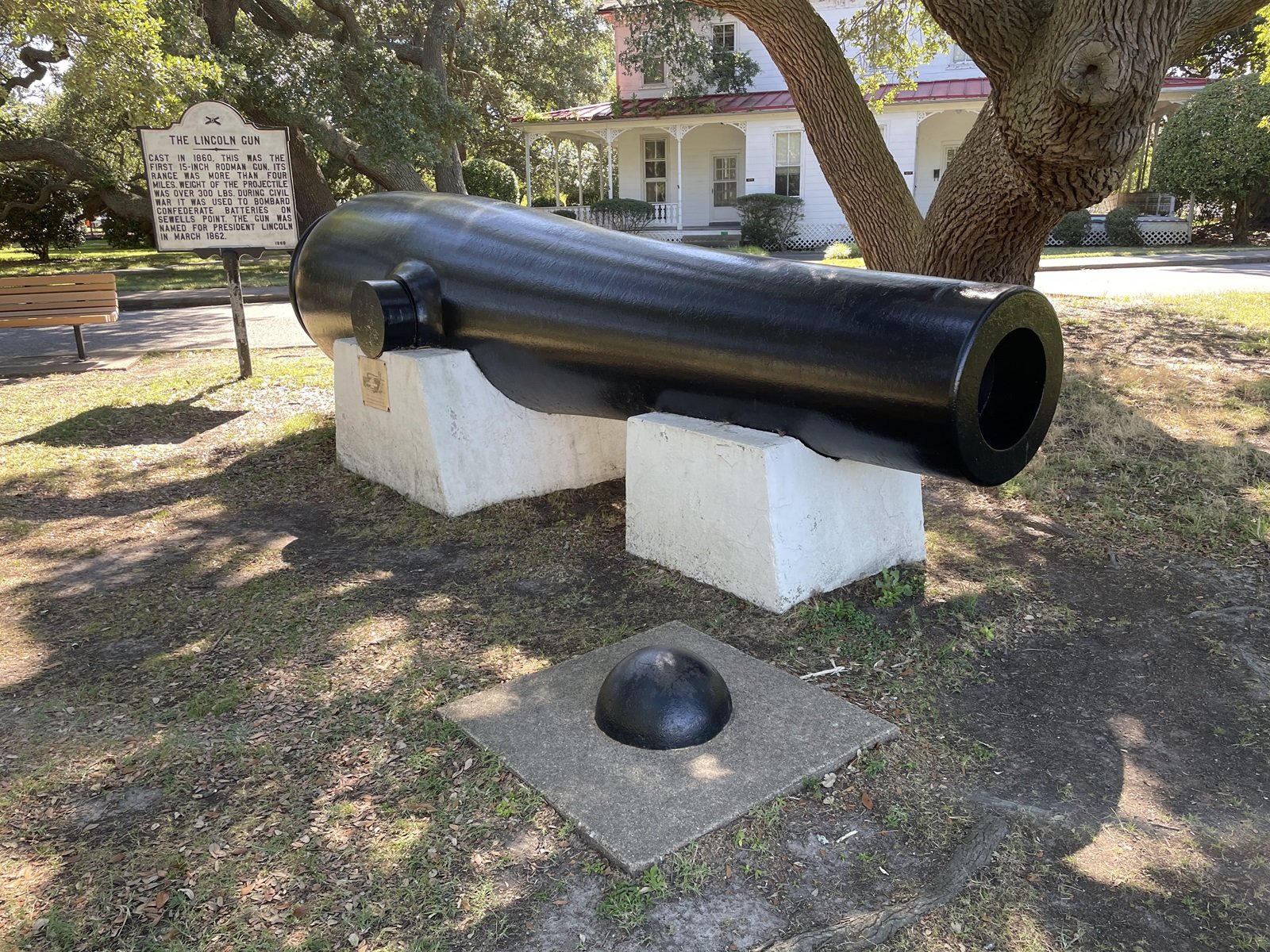The Lincoln Gun - Prototype 15-Inch Rodman at Fort Monroe
The “Lincoln Gun” - the Prototype 15-Inch Rodman on display at Fort Monroe in Virginia
The Rodman cannon which was eventually named the “Lincoln Gun” and which was the prototype 15-Inch smoothbore for the US Army (and in a way the US Navy as well) is displayed on the parade ground at Fort Monroe in Virginia. It was cast in 1860 at Fort Pitt Foundry. It bears the initials of its inventor “TJR” on muzzle. On its breech its weight is stamped: 49,099 pounds.
As I have described in previous posts, US Army officer Thomas Jackson Rodman developed a hollow casting technique in the 1850s that cooled the molten cannon from the inside out and therefore slightly contract from the inside out. This technique made much larger castings possible. Whereas 10-Inch Columbiads had weighed about 15,000 pounds, the 15-Inch Rodman weighed nearly 50,000 pounds. The 15-Inch Rodman fired a 440 pound shot (or 350-pound shell) with a 40-pound charge of powder. Range was around four miles.
According to Warren Ripley’s Artillery and Ammunition of the Civil War, the Lincoln Gun is about 3 inches shorter in overall length than the “production model” of the cannon. Those familiar with Rodmans and Columbiads will notice that the Lincoln gun has ratchets on its breech like previous models of the Columbiad and like the Confederate Columbiads. However, most (all?) other existent Rodman guns have oval shaped sockets on the breech.
In The Big Guns, Olmstead, Stark, and Tucker describe the reason for the change from ratchets to sockets. The Lincoln gun has a preponderance of around 1,000 pounds - meaning if balanced on its trunnions, the breech pushes down with 1,000 pounds more force than the muzzle. Previous Columbiads had been elevated by allowing the this preponderance to lift the muzzle. When required to depress the cannon, the gunners used handspikes to lift the breech- the ratchets clicking past to maintain their progress. This system proved unworkable on the huge scale of the 15-Inch. It was possible for even the 1,000 pounds of preponderance to be counteracted by the force of friction upon the trunnions. In this case, the one-way ratchets provided no help to the gunners. Subsequent Rodmans were cast with the trunnions placed so that the cannon would balance evenly. The oval-shaped sockets later adapted for subsequent Rodmans of all calibers allowed gunners to place a handspike into the socket to help elevate or depress the cannon - only needing to overcome the friction of the trunnions upon the carriage.
This specific cannon significantly impacted the development of US Naval ordnance. During the Battle of Hampton Roads between USS Monitor and CSS Virginia, the Lincoln Gun was at Fort Monroe. Following the battle in which Monitor’s 11-Inch Dahlgrens had been unable to break through CSS Virginia’s sloped 4-inch armor, the size and power of the 15-Inch Lincoln Gun made an impression on Gustavus Fox, the US Assistant Secretary of the Navy. Fox ordered John Dahlgren to design a 15-Inch cannon for the US Navy. Dahlgren, who seems to have already begun designing a 15-Inch, designed the gun which was cast using Rodman’s technique. In battle, the 15-Inch Dahlgren proved capable of breaking the armor of CSN ironclads, but even under the best conditions it took around 7 minutes to load and fire, and Admiral Dahlgren never trusted its reliability - fearing an explosion in a turret would disable or destroy a monitor. In his reports about the actions of his monitors off Charleston in late 1863, he praises his 11-Inch Dahlgrens but can find little good to say about the ponderous 15-Inch. This comment about the bombardment of Battery Wagner is typical: “The work of the day acquainted me with some points of the Monitors, the endurance was capital - my own vessel had been struck 67 times but the ponderous XV-inch was too slow in repeating fire - which was its own fault and not that of the Monitor and a fatal defect in hammering earth works, for which rapid fire is needed.” (Dahlgren, John. Autobiograpy. Chapter 4 “Promotion, Command of the South Atlantic Blockading Squadron, and the Siege of Charleston, 1863). It seems that Dahlgren would have preferred to create a cannon of about 13 inches in caliber.
Due to the success of the Lincoln Gun, the 15-Inch smoothbore would go on to be the heaviest cannon in regular use with both the US Army and the US Navy during and after the American Civil War. 15-Inch Rodmans were placed US Army seacoast fortifications to defend against ironclad attack. 15-Inch Dahlgrens were used to arm the coastal and seagoing monitors of the fleet.
“Guns for the Monitors” - Article in Naval History by Eugene B. Canfield which describes the adoption and development of the 15-Inch in US Navy service.
While 15-Inch Dahlgrens saw considerable combat service, the Lincoln Gun may have been one of the few (if not the only) 15-Inch Rodman to have been fired in anger. The cannon was used to bombard Confederate defenses on Sewell’s Point. I’ve also seen reference to the Lincoln Gun being fired (at long range and without achieving any hits) at CSS Virginia during the Battle of Hampton Roads - if you know a reliable source that confirms this, I’d be glad to read it.
Ratchets on the breech of the Lincoln Gun (top) and sockets on a production 15-Inch Rodman at Fort Sumter (bottom).
Library of Congress photo labeled as the Lincoln Gun at Fort Monroe in 1864. https://www.loc.gov/item/2012646299/














